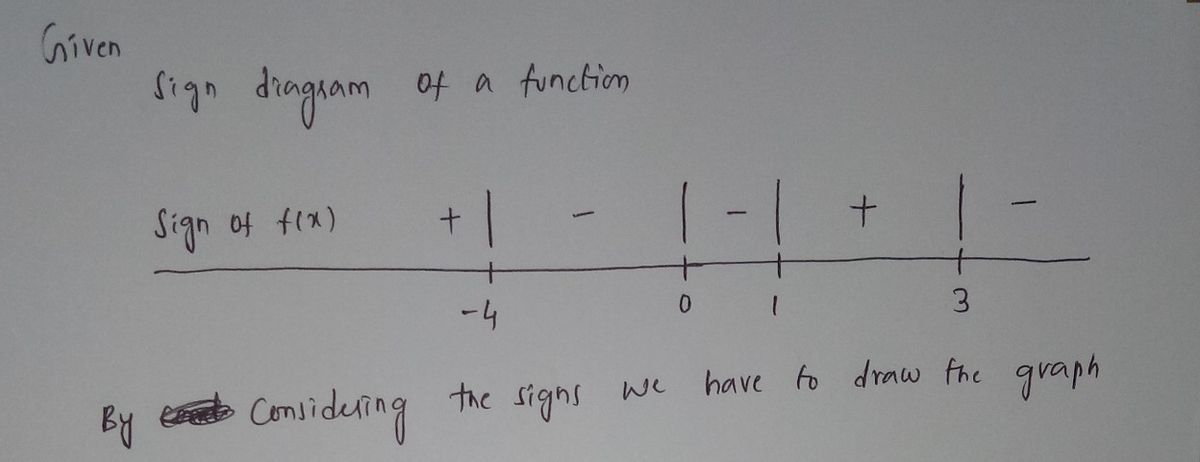**Title:** Sketching the Graph of a Polynomial Using a Sign Diagram **Introduction:** In this section, we will learn how to sketch the graph of a polynomial based on its sign diagram. **Sign Diagram Explanation:** The sign diagram provided represents the sign of the function \( f(x) \) over different intervals on the x-axis: - \( x < -4 \): The interval where \( f(x) \) is positive (+). - \( x = -4 \): A point where \( f(x) \) is equal to zero (0). - \(-4 < x < 0 \): The interval where \( f(x) \) is negative (−). - \( x = 0 \): A point where \( f(x) \) is equal to zero (0). - \( 0 < x < 3 \): The interval where \( f(x) \) is positive (+). - \( x = 3 \): A point where \( f(x) \) is equal to zero (0). - \( x > 3 \): A point where \( f(x) \) is zero (=). **Objective:** Use this sign information to help sketch the polynomial graph, identifying intervals of positivity/negativity and the roots of the polynomial where the graph intercepts the x-axis.
**Title:** Sketching the Graph of a Polynomial Using a Sign Diagram **Introduction:** In this section, we will learn how to sketch the graph of a polynomial based on its sign diagram. **Sign Diagram Explanation:** The sign diagram provided represents the sign of the function \( f(x) \) over different intervals on the x-axis: - \( x < -4 \): The interval where \( f(x) \) is positive (+). - \( x = -4 \): A point where \( f(x) \) is equal to zero (0). - \(-4 < x < 0 \): The interval where \( f(x) \) is negative (−). - \( x = 0 \): A point where \( f(x) \) is equal to zero (0). - \( 0 < x < 3 \): The interval where \( f(x) \) is positive (+). - \( x = 3 \): A point where \( f(x) \) is equal to zero (0). - \( x > 3 \): A point where \( f(x) \) is zero (=). **Objective:** Use this sign information to help sketch the polynomial graph, identifying intervals of positivity/negativity and the roots of the polynomial where the graph intercepts the x-axis.
Calculus: Early Transcendentals
8th Edition
ISBN:9781285741550
Author:James Stewart
Publisher:James Stewart
Chapter1: Functions And Models
Section: Chapter Questions
Problem 1RCC: (a) What is a function? What are its domain and range? (b) What is the graph of a function? (c) How...
Related questions
Question

Transcribed Image Text:**Title:** Sketching the Graph of a Polynomial Using a Sign Diagram
**Introduction:**
In this section, we will learn how to sketch the graph of a polynomial based on its sign diagram.
**Sign Diagram Explanation:**
The sign diagram provided represents the sign of the function \( f(x) \) over different intervals on the x-axis:
- \( x < -4 \): The interval where \( f(x) \) is positive (+).
- \( x = -4 \): A point where \( f(x) \) is equal to zero (0).
- \(-4 < x < 0 \): The interval where \( f(x) \) is negative (−).
- \( x = 0 \): A point where \( f(x) \) is equal to zero (0).
- \( 0 < x < 3 \): The interval where \( f(x) \) is positive (+).
- \( x = 3 \): A point where \( f(x) \) is equal to zero (0).
- \( x > 3 \): A point where \( f(x) \) is zero (=).
**Objective:**
Use this sign information to help sketch the polynomial graph, identifying intervals of positivity/negativity and the roots of the polynomial where the graph intercepts the x-axis.
Expert Solution
Step 1

Trending now
This is a popular solution!
Step by step
Solved in 2 steps with 2 images

Recommended textbooks for you

Calculus: Early Transcendentals
Calculus
ISBN:
9781285741550
Author:
James Stewart
Publisher:
Cengage Learning

Thomas' Calculus (14th Edition)
Calculus
ISBN:
9780134438986
Author:
Joel R. Hass, Christopher E. Heil, Maurice D. Weir
Publisher:
PEARSON

Calculus: Early Transcendentals (3rd Edition)
Calculus
ISBN:
9780134763644
Author:
William L. Briggs, Lyle Cochran, Bernard Gillett, Eric Schulz
Publisher:
PEARSON

Calculus: Early Transcendentals
Calculus
ISBN:
9781285741550
Author:
James Stewart
Publisher:
Cengage Learning

Thomas' Calculus (14th Edition)
Calculus
ISBN:
9780134438986
Author:
Joel R. Hass, Christopher E. Heil, Maurice D. Weir
Publisher:
PEARSON

Calculus: Early Transcendentals (3rd Edition)
Calculus
ISBN:
9780134763644
Author:
William L. Briggs, Lyle Cochran, Bernard Gillett, Eric Schulz
Publisher:
PEARSON

Calculus: Early Transcendentals
Calculus
ISBN:
9781319050740
Author:
Jon Rogawski, Colin Adams, Robert Franzosa
Publisher:
W. H. Freeman


Calculus: Early Transcendental Functions
Calculus
ISBN:
9781337552516
Author:
Ron Larson, Bruce H. Edwards
Publisher:
Cengage Learning